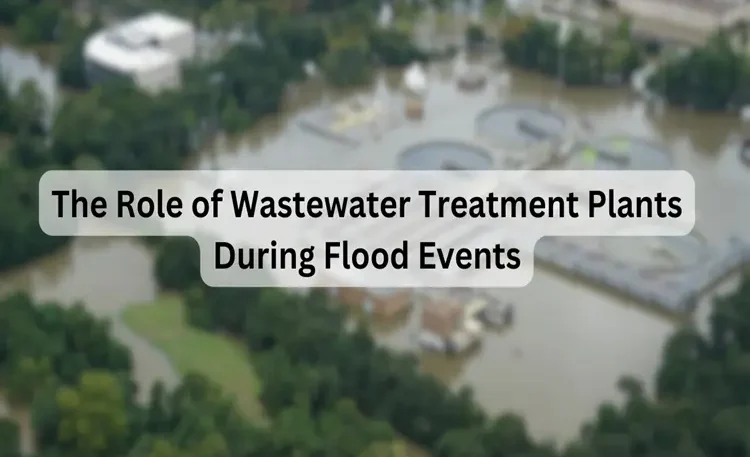Floods are a devastating force of nature. While the immediate impacts—damaged homes, disrupted transport, and property loss—are easily seen, there is another, less visible threat that often accompanies flood events: the release of untreated wastewater into the environment. Wastewater treatment plants (WWTPs), which normally function quietly and efficiently, suddenly find themselves at the frontline of a public health crisis during floods. Their role becomes critical in safeguarding human health, protecting ecosystems, and ensuring the resilience of cities in the face of extreme weather events.
This article explores the indispensable role wastewater treatment plants play during flood events, the challenges they face, the risks associated with their failure, and the strategies needed to build more resilient systems for the future.
Why Wastewater Treatment Plants Matter More During Floods
Under normal conditions, wastewater treatment plants collect sewage and industrial waste from homes, businesses, and factories, treat it to remove harmful substances, and release clean, safe water into the environment. However, floods disrupt this process, often pushing facilities to—and beyond—their designed capacity.
1. Preventing Raw Sewage Discharges
A wastewater treatment plant’s primary responsibility is to prevent untreated waste from entering natural water bodies. During flood events, massive amounts of stormwater overwhelm sewer systems, causing backflows and overflows. If treatment facilities fail, untreated or partially treated sewage escapes into rivers, lakes, and coastal waters, posing severe environmental and health risks.
2. Protecting Public Health
Floodwaters carrying raw sewage are a breeding ground for harmful bacteria, viruses, and parasites. Without adequate treatment, communities face outbreaks of waterborne diseases such as cholera, dysentery, hepatitis A, and giardiasis. By continuing operations during floods, wastewater treatment plants act as a barrier between contamination and human populations.
3. Safeguarding Ecosystems
Healthy waterways support fisheries, wetlands, and recreational activities that are essential to both livelihoods and ecosystems. When untreated sewage enters rivers and lakes, it introduces excess nutrients, heavy metals, and toxic chemicals that lead to algal blooms, oxygen depletion, and massive fish kills. Maintaining wastewater treatment processes during floods helps to prevent irreversible damage to aquatic life.
Challenges Faced by Treatment Plants During Floods
Despite their importance, wastewater treatment plants are highly vulnerable during flood events. The challenges they face include:
1. Overwhelmed Systems : Heavy rains cause surges of stormwater that enter sewer networks at volumes far exceeding their design limits. In many urban areas, combined sewer systems transport both sewage and stormwater through the same pipes. When rainfall intensifies, the system cannot cope, resulting in bypasses or uncontrolled discharges.
2. Power Outages : Most wastewater treatment processes require continuous electricity. Pumps, aerators, and disinfection units cannot operate without power. Flood-induced outages can halt treatment operations within hours, forcing untreated wastewater into surrounding communities.
3. Infrastructure Damage : Floodwaters are not only large in volume but also forceful. They can corrode pipes, short out electrical systems, and damage sludge handling mechanisms. Even brief exposure to floodwaters can compromise equipment, requiring costly repairs or replacements.
4. Bypass Events : To prevent catastrophic system failure, plants may be forced to bypass the usual treatment processes and discharge untreated or partially treated sewage directly into nearby water bodies. These emergency measures, while necessary to avoid structural damage, increase health and environmental risks.
Public Health and Environmental Impacts of Treatment Plant Failures
The repercussions of WWTP failure during floods extend beyond immediate discomfort or inconvenience. They ripple through public health systems, economies, and natural ecosystems.
1. Increased Disease Risk: Waterborne diseases spike rapidly in the aftermath of floods. Untreated sewage introduces pathogens that contaminate drinking water sources and recreational areas. Vulnerable groups—children, the elderly, and people with compromised immune systems—are at particular risk. Epidemics of cholera or dysentery can overwhelm healthcare infrastructure and lead to preventable deaths.
2. Drinking Water Contamination : Floodwaters carrying sewage can infiltrate wells, pipelines, and reservoirs, contaminating municipal water supplies. Once contaminated, restoring water safety requires extensive purification efforts, increased testing, and public communication—all of which strain local resources during emergencies.
3. Ecosystem Damage : The ecological toll is equally alarming. Excess nutrients like nitrogen and phosphorus encourage harmful algal blooms that produce toxins lethal to fish and marine animals. Heavy metals and industrial pollutants accumulate in sediments, degrading the health of wetlands and coastal ecosystems for years. The collapse of fish populations or loss of biodiversity can also affect livelihoods dependent on these resources.
4. Economic Strain : The economic costs of wastewater-related flood damage are staggering. Clean-up efforts, healthcare expenditures, and infrastructure repairs strain municipal budgets. In many cases, low-income communities bear the brunt of these costs, amplifying social inequalities and slowing recovery.
Building Resilience: How Treatment Plants Can Adapt
With floods expected to become more frequent and intense due to climate change, wastewater treatment plants must be redesigned to withstand extreme weather. The following strategies are key to enhancing resilience:
1. Elevating and Flood-Proofing Critical Equipment : One of the most straightforward strategies is to physically protect equipment by raising it above projected flood levels. Electrical panels, pumps, and disinfection units can be housed in elevated or watertight enclosures to prevent damage during floods.
2. Backup Power Systems : To avoid disruptions caused by power outages, facilities must invest in backup generators and renewable energy sources like solar microgrids. These systems ensure that essential pumps and aeration units continue operating even when the grid goes down.
3. Stormwater Diversion Systems : Temporary storage systems, such as holding tanks or retention ponds, can be used to divert excess stormwater during peak inflows. These systems buy critical time, allowing plants to process wastewater without becoming overwhelmed.
4. Green Infrastructure Solutions : Upstream interventions are equally important. Restoring wetlands, constructing rain gardens, and implementing permeable pavements help absorb rainwater before it enters sewer systems. Such measures reduce the volume of inflow, alleviating pressure on treatment facilities.
5. Emergency Preparedness and Protocols : Treatment plants should develop detailed emergency plans that include guidelines for bypass events, disinfection procedures, public communication, and collaboration with health authorities. Well-rehearsed protocols enable rapid responses and minimize panic during actual events.
The Bigger Picture: Wastewater Infrastructure in the Era of Climate Change
Flood-related risks are not isolated incidents; they are part of a broader pattern linked to climate change, urbanization, and aging infrastructure. Coastal cities face sea-level rise, while inland communities experience heavier rainfall and flash floods. As urban sprawl accelerates, combined sewer systems become increasingly inadequate, and flood events test the limits of outdated facilities.
Investing in wastewater resilience is not simply an engineering challenge—it is a societal imperative. Health departments, environmental agencies, urban planners, and local governments must collaborate to design systems that are adaptable, sustainable, and equitable.
Public awareness is also critical. Communities that understand how wastewater treatment works and why it matters are more likely to support infrastructure improvements, engage in proactive planning, and respond effectively during emergencies.
Case Studies: Lessons from Around the World
Several regions have already begun transforming their wastewater treatment strategies to address flood risks:
New York City, USA
Following Hurricane Sandy, New York invested heavily in elevating critical infrastructure and deploying backup generators. The city also improved stormwater capture with green roofs and rain gardens, reducing inflow during storms.
Jakarta, Indonesia
With rising flood risks, Jakarta has begun separating stormwater from sewage systems and investing in large-scale retention ponds. Community education campaigns have also improved sanitation practices in flood-prone neighborhoods.
Rotterdam, Netherlands
Rotterdam has become a global leader in climate adaptation, integrating green infrastructure and flood barriers with wastewater management. Their approach blends engineering innovation with ecological restoration.
These examples demonstrate that resilience is possible when governments prioritize investment, planning, and community engagement.
Final Thoughts :
Wastewater treatment plants are unsung heroes in the fight against flood-related disasters. While they operate behind the scenes during normal times, their importance becomes glaringly apparent when disaster strikes. By preventing the uncontrolled release of harmful pollutants, these facilities protect public health, preserve ecosystems, and uphold the integrity of urban life.
Yet, floods expose the vulnerabilities of our current systems. Aging infrastructure, insufficient capacity, and power disruptions can transform wastewater plants from shields into sources of contamination. The need for proactive planning, climate-resilient designs, and community collaboration has never been greater.
The path forward requires innovation, investment, and empathy. Elevating equipment, deploying backup power, building green infrastructure, and preparing comprehensive emergency protocols are steps that can ensure treatment plants remain operational when cities need them most.
In the era of climate change, wastewater treatment is no longer a hidden utility—it is a cornerstone of disaster resilience, public health, and environmental stewardship. By strengthening these vital systems today, we can protect communities and ecosystems tomorrow, ensuring that floods are managed with intelligence, foresight, and care.





